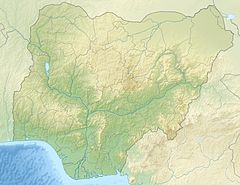Atamora Rock Shelter
Script error: No such module "Draft topics".
Script error: No such module "AfC topic".
Atamora Rock Shelter[edit]
| Location | Atamora village |
|---|---|
| Region | Osun State |
| Coordinates | 7°25′N 4°18′E / 7.417°N 4.300°ECoordinates: 7°25′N 4°18′E / 7.417°N 4.300°E ⧼validator-fatal-error⧽ |
| History | |
| Periods | Mesolithic, Neolithic, Iron Age |
| Site notes | |
| Excavation dates | 2003 to 2004 |
| Archaeologists | Jere Joel Akpobasa |
Atamora Rock Shelter is an archaeological site situated in the forest area of southwest Nigeria, in Osun State.[1] In 1985, during his research into the terracotta traditions in the area, Eluyemi mentioned this site for the first time. The site is named after the village Atamora, where the rock shelter is situated.[2] The first excavations at the rock shelter took place in 2003-2004 with the aim of identifying human occupation in the forest zone of southwest Nigeria. This as a counter-research against the assumptions that humans could not have survived in this forest zone before the emergence of metal.[2] Those excavations were performed by Jere Joel Akpobasa in collaboration with the Department of Archaeology and Anthropology, University of Ibadan. [2]
Location[edit]
Atamora Rock Shelter is situated at 500 m east of Atamora village. Atamora village is inhabited by farming communities belonging to the Iwata people, who own the land on which the rock shelter is situated.[2] The Iwata people are a Yoruba community living in the part of the Yoruba speaking people in southwest Nigeria.[2] The rock shelter is situated in the forest area of Osun State.[2]
Structural characteristics[edit]
The rock shelter is part of an east-west running granite rim. The geophysical setting of the rock shelter is typified by an overhang plate that rests on the ground at the northern side. At the southwest and southeast, the overhang plate also rests on two smaller blocks. In this way, there is an opening towards the south, this forms the opening to the main area or hall of the rock shelter. Furthermore, there are two other chambers, one of which is under the small support block in the southeast and the other one is at the northern extremity.[2] Throughout time, the rock shelter has endured many weather impacts, this is proved by the hollows in the exterior of the rock shelter that function as reservoirs for rainwater.[2]
Excavations[edit]
An overview of the materials found at Atamora Rock Shelter during fieldwork carried out by Jere Joel Akpobasa in collaboration with the Department of Archaeology and Anthropology, University of Ibadan between 2003 and 2004:[2]
Lithic materials[edit]
Microliths and macroliths[edit]
Microliths form the largest category of materials recovered. Jere Joel Akpobasa and his team identified, during their fieldwork between 2003 and 2004, that 79% of all materials found were microliths.[2] Macroliths represented 13% of the artefacts found. Most materials are made by systematic core preparation. The found lithic artefacts can be divided into several categories based on appearance, the main ones being: fragments, chips, blades and chunks/nodules. The most prominent materials in which the artefacts were found are quartz, quartzite and clay. [2]
Non-lithic materials[edit]
Pottery and terracotta[edit]
Pottery found was 5.8% of the non-lithic materials and thereby the largest category among the non-lithic artefacts. One of the categories found is a unique mug tradition, this is specific to Atamora Rock Shelter because this phenomenon was not found in surrounding study areas. In addition, several terra cotta objects were found.[2]
Metals[edit]
There were a few metal objects found (11 pieces in total). Most of them were unidentifiably due to a level of rustiness. One was identified as part of an arrow.[2]
Beads[edit]
One bead was found during the excavation. It consists of a quartz-like material.[2]
Organic[edit]
Only a small portion of the material found was organic. In total this was 1.9%. This included bones, nuts and cowry shells.[2]
Time framing and context[edit]
The time dating of Atamora Rock Shelter is most likely Middle Stone Age and Late Stone Age. This is driven by the fact that most artefacts consist of quartz or quartzite.
There are findings of pottery, so it can be assumed that there is a probability that pottery was made and used here. This situates the rock shelter in the Neolithic phase.There are several hypotheses about the use of pottery in this rock shelter. One of these assumptions is that farmers hid in the rock shelter from rain and then cooked in the pots, there are also assumptions that it has to do with religious reasons.[2]
References[edit]
- ↑ Opadeji, O. A. (2020). An Archaeological Study of Early Farming Settlements on Iresi Hills. yoruba studies review, 305.
- ↑ 2.00 2.01 2.02 2.03 2.04 2.05 2.06 2.07 2.08 2.09 2.10 2.11 2.12 2.13 2.14 2.15 Akpobasa, J. J. (2009). Stone Age Studies in Southwest Nigeria with particular emphasis on the assessment of material from Atamora Rock Shelter (Doctoral dissertation, Tübingen, Univ., Diss., 2005).
Project page[edit]
This article was written as part of the WikiProject African Archaeology project. GeertivpBot (talk) 10:42, 10 March 2023 (UTC)
This article "Atamora Rock Shelter" is from Wikipedia. The list of its authors can be seen in its historical and/or the page Edithistory:Atamora Rock Shelter. Articles copied from Draft Namespace on Wikipedia could be seen on the Draft Namespace of Wikipedia and not main one.

